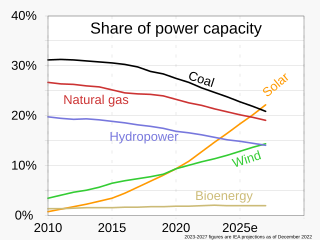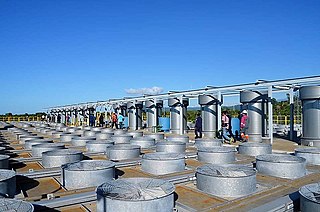Irena may refer to:
Irena may refer to:

Renewable energy is energy from renewable resources that are naturally replenished on a human timescale. Renewable resources include sunlight, wind, the movement of water, and geothermal heat. Although most renewable energy sources are sustainable, some are not. For example, some biomass sources are considered unsustainable at current rates of exploitation. Renewable energy is often used for electricity generation, heating and cooling. Renewable energy projects are typically large-scale, but they are also suited to rural and remote areas and developing countries, where energy is often crucial in human development. Renewable energy is often deployed together with further electrification, which has several benefits: electricity can move heat or objects efficiently, and is clean at the point of consumption.

A non-renewable resource is a natural resource that cannot be readily replaced by natural means at a pace quick enough to keep up with consumption. An example is carbon-based fossil fuels. The original organic matter, with the aid of heat and pressure, becomes a fuel such as oil or gas. Earth minerals and metal ores, fossil fuels and groundwater in certain aquifers are all considered non-renewable resources, though individual elements are always conserved.

A renewable resource is a natural resource which will replenish to replace the portion depleted by usage and consumption, either through natural reproduction or other recurring processes in a finite amount of time in a human time scale. When the recovery rate of resources is unlikely to ever exceed a human time scale, these are called perpetual resources. Renewable resources are a part of Earth's natural environment and the largest components of its ecosphere. A positive life-cycle assessment is a key indicator of a resource's sustainability.

Energy is sustainable if it "meets the needs of the present without compromising the ability of future generations to meet their own needs." Most definitions of sustainable energy include considerations of environmental aspects such as greenhouse gas emissions and social and economic aspects such as energy poverty. Renewable energy sources such as wind, hydroelectric power, solar, and geothermal energy are generally far more sustainable than fossil fuel sources. However, some renewable energy projects, such as the clearing of forests to produce biofuels, can cause severe environmental damage.

Biomass (for energy) is matter from recently living (but now dead) organisms which is used for bioenergy production. Examples include wood, wood residues, energy crops, agricultural residues, and organic waste from industry and households. Wood and wood residues is the largest biomass energy source today. Wood can be used as a fuel directly or processed into pellet fuel or other forms of fuels. Other plants can also be used as fuel, for instance maize, switchgrass, miscanthus and bamboo. The main waste feedstocks are wood waste, agricultural waste, municipal solid waste, and manufacturing waste. Upgrading raw biomass to higher grade fuels can be achieved by different methods, broadly classified as thermal, chemical, or biochemical.
Resource refers to all the materials available in our environment which are technologically accessible, economically feasible and culturally sustainable and help us to satisfy our needs and wants. Resources can broadly be classified upon their availability — they are classified into renewable and non-renewable resources. They can also be classified as actual and potential on the basis of the level of development and use, on the basis of origin they can be classified as biotic and abiotic, and on the basis of their distribution, as ubiquitous and localised. An item becomes a resource with time and developing technology. The benefits of resource utilization may include increased wealth, proper functioning of a system, or enhanced well-being. From a human perspective, a natural resource is anything obtained from the environment to satisfy human needs and wants. From a broader biological or ecological perspective, a resource satisfies the needs of a living organism.
Green jobs are, according to the United Nations Environment Program, "work in agricultural, manufacturing, research and development (R&D), administrative, and service activities that contribute(s) substantially to preserving or restoring environmental quality. Specifically, but not exclusively, this includes jobs that help to protect ecosystems and biodiversity; reduce energy, materials, and water consumption through high efficiency strategies; de-carbonize the economy; and minimize or altogether avoid generation of all forms of waste and pollution." The environmental sector has the dual benefit of mitigating environmental challenges as well as helping economic growth.
Energy in Botswana is a growing industry with tremendous potential. However almost all Botswana's electricity is generated from coal. No petroleum reserves have been identified and all petroleum products are imported refined, mostly from South Africa. There is extensive woody biomass from 3 to 10t / hectare.
Djibouti's electrical energy is supplied primarily by thermal plants and imported hydroelectricity from Ethiopia. However, the supplemental supply of power from Ethiopia does not always satisfy Djibouti’s demand for power. According to USAID's Energy sector overview for djibouti, Djibouti has the potential to generate more than 300MW of electrical power from renewable energy sources, and much more from other resources. Based on 2020 data, Djibouti’s national electrification rate reached 42%,.
A ministry of energy or department of energy is a government department in some countries that typically oversees the production of fuel and electricity; in the United States, however, it manages nuclear weapons development and conducts energy-related research and development. The person in charge of such a department is usually known as a minister of energy or minister for energy.
The Polish energy sector is the sixth largest in Europe. The scale of energy consumption in 1996–2015 increased from 139,593 GWh to 161,438 GWh. According to the data of Polskie Sieci Elektroenergetyczne (PSE), electricity production in October 2020 amounted to 13,553 GWh; domestic consumption amounted to 14,798 GWh.

Renewable energy in Lithuania constitutes some energy produced in the country. In 2016, it constituted 27.9% of the country's overall electricity generation. Previously, the Lithuanian government aimed to generate 23% of total power from renewable resources by 2020, the goal was achieved in 2014 (23.9%).

Ninfa Clara Salinas Sada is a Mexican politician. she is a marketing specialist from Universidad Anáhuac de México, she has an extensive political career being a current member of the Partido Verde Ecologista de México. In Mexican politics she is recognized as one of the youngest women in the country in holding a political position, and as an important figure who drives laws in benefit of the environment. Currently she holds the position of President at Grupo Dragón, a company that generates electricity from renewable energy.

The International Renewable Energy Agency (IRENA) is an intergovernmental organization mandated to facilitate cooperation, advance knowledge, and promote the adoption and sustainable use of renewable energy. It is the first international organisation to focus exclusively on renewable energy, addressing needs in both industrialised and developing countries. It was founded in 2009 and its statute entered into force on 8 July 2010. The agency is headquartered in Masdar City, Abu Dhabi. The Director-General of IRENA is Francesco La Camera, a national of Italy. IRENA is an official United Nations observer.
The Energy and Environmental Engineering field seeks to conserve and maintain the natural environment by using efficient sources of energy. Energy and environmental engineers are continually searching for solutions to emerging, environment-related issues such as erosion, water disposal, air and water pollution, land resources, human health, and environmental restoration.
Concept of smart villages is a global modern approach for off-grid communities. Vision behind this concept is to assist the policy makers, donors and socio-economic planner for rural electrification worldwide.

Renewable energy in South Africa is energy generated in South Africa from renewable resources, those that naturally replenish themselves—such as sunlight, wind, tides, waves, rain, biomass, and geothermal heat. Renewable energy focuses on four core areas: electricity generation, air and water heating/cooling, transportation, and rural energy services. The energy sector in South Africa is an important component of global energy regimes due to the country's innovation and advances in renewable energy. South Africa's greenhouse gas (GHG) emissions is ranked as moderate and its per capita emission rate is higher than the global average. Energy demand within the country is expected to rise steadily and double by 2025.
Adnan Z. Amin is a Kenyan diplomat and a development economist with a specialty in sustainable development. He served as the first Director-General of the Abu Dhabi-based intergovernmental organisation, the International Renewable Energy Agency (IRENA). Amin was elected in April 2011, having previously served as the Agency's Interim Director-General in 2010. Prior to his appointment at the IRENA, he worked in a variety of senior positions within the United Nations system in areas relating to in renewable energy, sustainable development and environmental policy. He served as the Director of the New York Office of United Nations Environment Programme (UNEP) and Special Representative of the UNEP Executive Director.
As of 2021 there was little renewable energy in Belarus but a lot of potential. 7% of primary energy in Belarus was from renewables in 2019, mostly biofuels. As there is a lot of district heating more renewables could be integrated into that, but this is hindered by fossil fuel subsidies.

East Timor consumes 125 GWh of electricity per annum, an average of 95 kWh per person. The country has about 270 MW of electricity capacity, 119 MW in the city of Hera.